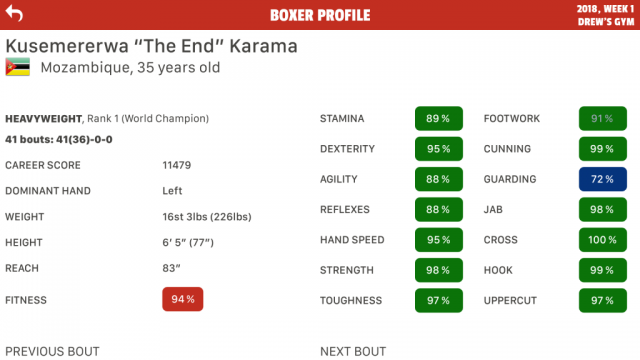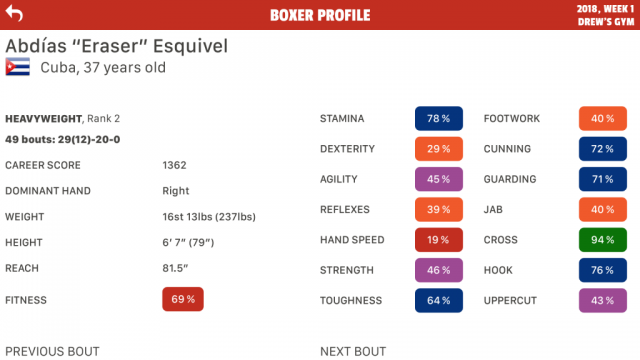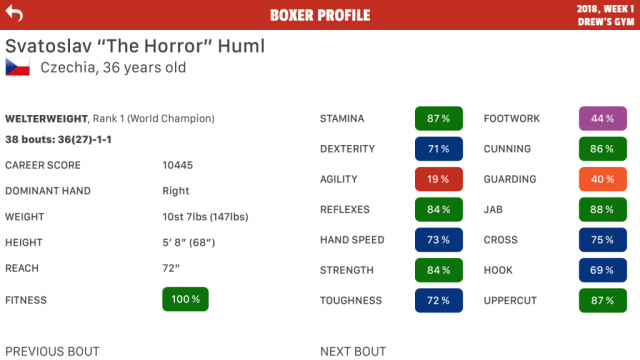As with all the ringcraft attributes, Agility and Reflexes have multiple functions in Leather, but I’d like to explain what they mean for purely their defensive mechanisms. This will hopefully clear up some of the misunderstandings around exactly what ‘Agility’ refers to, how it contrasts with ‘Reflexes’, and what a ‘proactive’ defence is in contrast to a ‘reactive’ defence.
Agility, in defensive terms, governs upper body movement. This takes the form of slips, ducks and bobs, among other things, and despite manifesting as upper body movement these are mostly driven from the legs. To slip to the right an orthodox boxer pushes from their lead (left) leg and turns at the waist, tucking their head and lead (left) shoulder to the right, turning them slightly more side-on. To slip to the left they engage their rear (right) leg to twist the waist to the left, tucking the head and bringing the rear (right) shoulder forward, turning them slightly more square-on. The idea, as with any slip, duck, bob, tuck, roll, twitch, etc., is to take the head and body off the centre-line, so that typical shots thrown by the opponent skim past, sail overhead, or fly wide. Combining and sequencing these movements gives the boxer an array of options for avoiding incoming shots from different angles, be they straight or hooked, whilst setting up their own shots.
These techniques are used ‘proactively’: the boxer isn’t waiting for his opponent to throw a shot before attempting to dodge it. If a boxer tries to engage one of these manoeuvres after starting to see a shot coming they will simply get hit: a slip is a complex kinetic chain, and there isn’t enough time for a boxer’s brain to compute that a shot is coming and then engage and complete the dodge before the punch lands – even the slowest of punches are much too fast. ‘Proactive’ means that the best agile boxers are performing these moves constantly – they aren’t waiting for a shot to come at them; they’re already slipping, ducking, bobbing, rolling, twitching, etc.
Perhaps the best example would be a prime Joe Frazier: he had a very distinctive, herky-jerky style, meant to both avoid punches and provide constant feints to disguise his own shots – he never just stood still. I qualified that with the word ‘prime’, as once Frazier began to decline he couldn’t maintain this style anymore, resorting to a much more simplified and predictable series of constant straight-line ducks – watch the third fight with Muhammad Ali and you’ll see the difference. He lost his ability to remove himself from the centre-line, which made him much easier to hit with straight shots and uppercuts.
Whilst Agility can be used when boxing off the back-foot (i.e. when being less aggressive) it is not as effective, as these slips, ducks and bobs are easier to engage when a boxer’s weight is over the front foot – the boxer’s body mass naturally comes forward when slipping. To defend themselves properly when boxing off the back-foot a boxer needs good Reflexes.
Reflexes provide a boxer with a ‘reactive’ defence, which is the opposite of ‘proactive’. The boxer sees the shot coming and quickly jerks their head or turns their body out of the way. There’s no kinetic chain as such, and the aim is for the incoming punch to finish just an inch or two short of the target: the margins are tiny. This is, of course, not possible when a boxer has his weight over his front foot – as stated above there’s simply not enough spare milliseconds to dodge the shot – but if a boxer is fighting off the back foot then they have a few more slivers of time to play with because their upper body is ever-so-slightly further away from their opponent.
The most famous real world examples of superb Reflexes belong to Muhammad Ali (we’ve all seen the photograph of him leaning back as a Joe Frazier hook falls short). We must also remember Pernell Whitaker, who combined a superior reflex defence (when boxing at long-range) with awe-inspiring Agility, meaning he could dodge shots just as well when fighting in the pocket, like a slippery eel (the modern term, seemingly spawned from Vasyl Lomachenko’s preternatural abilities, is “Matrix Defence”, which in Leather translates to very high levels of both Agility and Reflexes).
The broad, over-simplified takeaways: if you’re a front-foot, come-forward, aggressive, attacking boxer, then you should prioritise Agility, whereas if you’re a back-foot, retreating, reactive, hit-and-move type, then you should prioritise Reflexes. This is an over-simplification because boxing matches are rarely one-way traffic: there are ebbs and flows as one boxer becomes the aggressor and then backs away, ceding space to his opponent, therefore concentrating purely on one area can lead to defensive frailties in the other. Likewise boxers rarely fight identically from bout to bout; instead needing to adjust their strategy and style according to their opponent – many times the winner is not the one who more dominantly exerts their own preferred style, but instead the one who denies his opponent the chance to fight in theirs. Common strategies are to back-up opponents who aren’t used to fighting purely off the back foot, or being hugely passive and forcing normally back-footed boxers to engage and be the aggressor.
As I stated at the beginning, Agility and Reflexes govern other areas in Leather, not just matters of avoiding incoming shots, but I hope that this post has cleared up a few misconceptions around what these defensive aspects entail, and should equip you with a better understanding of how to create boxers of different styles that always have a way to dodge shots, be that proactively or reactively.





